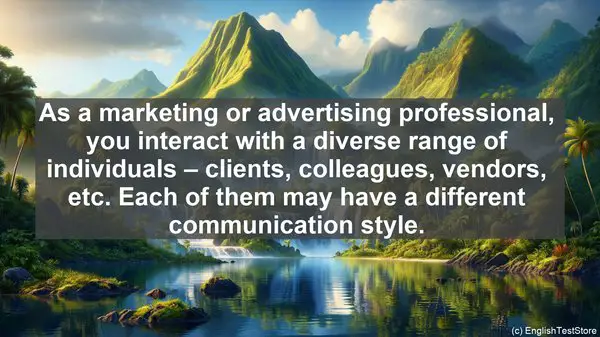Introduction: The Power of Effective Communication in Marketing and Advertising
Welcome to this video on advanced communication techniques in English for marketing and advertising. In today’s competitive world, effective communication is the key to success in any industry, and marketing and advertising are no exceptions. Whether it’s crafting compelling copy, delivering persuasive presentations, or engaging with clients, your communication skills play a crucial role. In this video, we’ll explore ten techniques that will take your communication skills to the next level. Let’s dive in!
1. Mastering the Art of Storytelling
Storytelling is an age-old technique that has stood the test of time. In marketing and advertising, a well-crafted story can captivate your audience, evoke emotions, and leave a lasting impact. Whether it’s a brand narrative, a social media post, or a video ad, infusing it with a compelling story can make it more memorable and relatable. So, hone your storytelling skills by studying narratives from different mediums, understanding the elements that make them powerful, and practicing weaving stories around your marketing messages.
2. Developing Active Listening Skills
Communication is not just about speaking; it’s also about listening. In marketing and advertising, actively listening to your clients, colleagues, and target audience is crucial. It helps you understand their needs, concerns, and expectations better, enabling you to tailor your communication accordingly. So, next time you’re in a meeting or a client call, focus not just on what you’re going to say, but also on truly hearing and comprehending what others are saying. This will not only improve your communication but also build stronger relationships.

3. Crafting Concise and Impactful Messages
In today’s fast-paced world, attention spans are shrinking. As a marketer or advertiser, you often have just a few seconds to grab your audience’s attention. That’s where the art of crafting concise and impactful messages comes in. Whether it’s a subject line, a headline, or a tagline, every word counts. So, practice the art of brevity. Cut out unnecessary fluff, focus on the core message, and use powerful words that resonate with your audience. Remember, less is often more in the world of marketing and advertising.
4. Adapting Your Communication Style
As a marketing or advertising professional, you interact with a diverse range of individuals – clients, colleagues, vendors, etc. Each of them may have a different communication style. To ensure effective communication, it’s essential to adapt your style to match theirs. For instance, if you’re dealing with a client who prefers a formal and structured approach, align your communication likewise. On the other hand, if you’re brainstorming with a creative team, a more open and flexible style might be appropriate. Being adaptable in your communication style can help you build rapport and avoid misunderstandings.
5. Leveraging Visuals for Enhanced Communication
They say a picture is worth a thousand words, and in marketing and advertising, that holds true. Visuals have the power to convey complex ideas, evoke emotions, and make your communication more engaging. Whether it’s using infographics in a presentation, incorporating eye-catching images in an ad, or creating visually appealing social media posts, visuals can elevate your communication. So, invest time in learning about design principles, graphic tools, and visual storytelling techniques. The visual aspect of your communication can often make or break its impact.
6. Practicing the Art of Persuasion
In marketing and advertising, persuasion is a valuable skill. Whether you’re trying to convince a client to choose your agency, a customer to buy your product, or a team to support your idea, your ability to persuade can make a significant difference. The key to effective persuasion lies in understanding your audience’s motivations, addressing their concerns, and presenting a compelling case. It’s about building a logical and emotional connection. So, study the principles of persuasion, learn from master persuaders, and practice crafting persuasive messages.

7. Embracing the Power of Non-Verbal Communication
Communication is not just about words; it’s also about non-verbal cues. In fact, research suggests that a significant portion of our communication is non-verbal – through body language, facial expressions, and tone of voice. In marketing and advertising, where building trust and establishing connections are crucial, mastering non-verbal communication is essential. So, pay attention to your body language, practice active listening through nodding and eye contact, and be mindful of your tone. A congruent non-verbal message can reinforce and enhance your verbal one.
8. Cultivating Cross-Cultural Communication Skills
In today’s globalized world, marketing and advertising often involve working with individuals from different cultures. Each culture has its unique communication norms, etiquettes, and sensitivities. Being aware of and respecting these differences is vital for effective cross-cultural communication. So, invest time in learning about different cultures, their communication styles, and the do’s and don’ts. When in doubt, ask for clarification, and never assume. A culturally sensitive approach can help you build trust and avoid potential misunderstandings or offense.
9. Nurturing Your Networking Skills
In marketing and advertising, networking is not just a buzzword; it’s a valuable tool for career growth and business opportunities. Effective networking involves not just attending events or connecting on social media but also building meaningful relationships. It’s about being genuinely interested in others, offering value, and maintaining regular communication. So, hone your networking skills by attending industry events, joining professional groups, and leveraging online platforms. Remember, in the world of marketing and advertising, your network can often be your biggest asset.
10. Continuous Learning and Improvement
Finally, in the ever-evolving world of marketing and advertising, the key to staying ahead is continuous learning and improvement. Communication trends, tools, and platforms are constantly changing. To ensure you’re not left behind, make learning a priority. Whether it’s attending workshops, reading industry blogs, or taking online courses, there are numerous resources available. Additionally, seek feedback from mentors, colleagues, and clients. Constructive feedback can highlight areas for improvement and help you refine your communication skills further.
